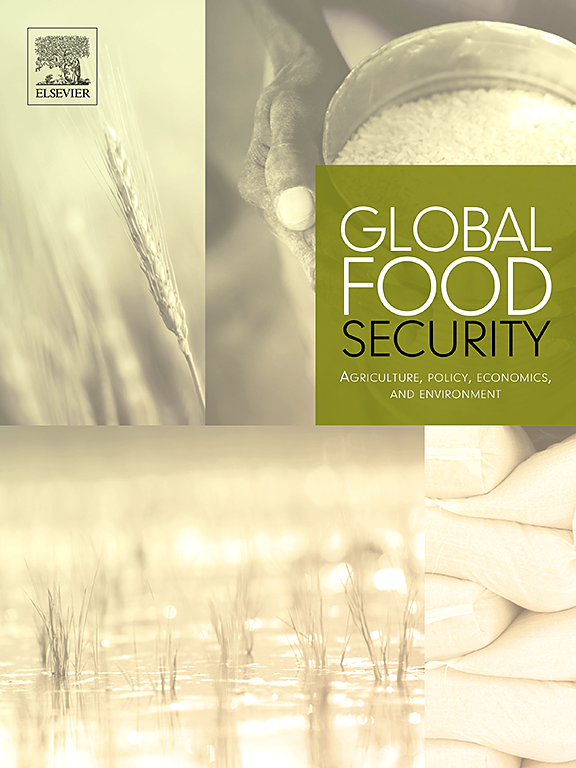未来粮食格局:人口下降和老龄化对中国膳食碳足迹和粮食安全的影响
IF 9.6
1区 经济学
Q1 FOOD SCIENCE & TECHNOLOGY
Global Food Security-Agriculture Policy Economics and Environment
Pub Date : 2025-07-23
DOI:10.1016/j.gfs.2025.100875
引用次数: 0
摘要
粮食系统是全球气候变化的主要贡献者,使其脱碳和可持续转型成为学术研究的关键领域。随着包括中国在内的许多国家经历人口快速老龄化,减少与食品有关的碳排放出现了新的挑战。不同年龄组的饮食偏好和根深蒂固的饮食习惯的差异,给未来饮食碳足迹的预测带来了很大的不确定性。本研究分析了不同年龄的膳食碳排放,模拟了人口老龄化对中国食物相关碳排放的影响,并探讨了饮食转型的驱动因素。利用2014年中国城市住户调查的微观数据,我们模拟了人口变化的影响——人口规模和结构——以及饮食行为的潜在变化。结果表明,由于人口萎缩,膳食碳排放总量可能在2030年左右达到峰值,然后下降。然而,随着人口老龄化,人均排放量将会增加。以健康为导向的饮食转型和农业技术进步可分别减少约10%至13%和22%至26%的排放量。尽管饮食系统可能面临减少的碳压力,但其他系统性风险可能会出现。值得注意的是,老龄化可能导致农业劳动力减少,加剧劳动力供给与粮食需求的不匹配,并对粮食安全构成额外风险。这些发现强调了提高农业效率、进行技术创新以及对城市化和乡村振兴战略采取谨慎协调的方法的必要性。本文章由计算机程序翻译,如有差异,请以英文原文为准。
Future foodscape: Impact of population decline and aging on China's dietary carbon footprint and food security
The food system is a major contributor to global climate change, making its decarbonization and sustainable transformation a critical area of academic inquiry. As many countries, including China, experience rapid population aging, new challenges emerge for reducing food-related carbon emissions. Variations in dietary preferences and entrenched eating habits across age groups introduce substantial uncertainty into projections of future dietary carbon footprints. This study analyzes age-specific dietary carbon emissions, simulates the impact of demographic aging on China's food-related emissions, and explores the drivers of dietary transitions. Using microdata from the 2014 China Urban Household Survey, we simulate the effects of demographic changes—both in population size and structure—and potential shifts in dietary behavior. The results indicate that total dietary carbon emissions are likely to peak and then decline around 2030 due to population contraction. However, per capita emissions will increase as the population ages. Health-oriented dietary transitions and technological advancements in agriculture could reduce emissions by approximately 10 %–13 % and 22 %–26 %, respectively. Although the dietary system may face reduced carbon pressure, other systemic risks could arise. Notably, aging may lead to a decline in the agricultural workforce, exacerbating mismatches between labor supply and food demand, and posing additional risks to food security. These findings underscore the need for improved agricultural efficiency, technological innovation, and a carefully coordinated approach to urbanization and rural revitalization strategies.
求助全文
通过发布文献求助,成功后即可免费获取论文全文。
去求助
来源期刊

Global Food Security-Agriculture Policy Economics and Environment
FOOD SCIENCE & TECHNOLOGY-
CiteScore
20.90
自引率
3.40%
发文量
69
期刊介绍:
Global Food Security plays a vital role in addressing food security challenges from local to global levels. To secure food systems, it emphasizes multifaceted actions considering technological, biophysical, institutional, economic, social, and political factors. The goal is to foster food systems that meet nutritional needs, preserve the environment, support livelihoods, tackle climate change, and diminish inequalities. This journal serves as a platform for researchers, policymakers, and practitioners to access and engage with recent, diverse research and perspectives on achieving sustainable food security globally. It aspires to be an internationally recognized resource presenting cutting-edge insights in an accessible manner to a broad audience.
 求助内容:
求助内容: 应助结果提醒方式:
应助结果提醒方式:


